Zendesk Support is a popular customer service platform that empowers teams to streamline ticket management and deliver outstanding support. However, many users in the Zendesk Community have identified areas where the platform could improve to help agents enhance tickets more effectively. In this post, we’ll explore which ticket enhancement features Zendesk supports natively, which require add-ons or custom solutions, and what’s still missing entirely.
What Zendesk Supports Natively
Zendesk offers several ticket enhancement features out of the box, ensuring agents can efficiently manage customer interactions:
1. Rich Text Formatting:
Zendesk provides basic rich text formatting for public replies and internal notes, enabling agents to improve the clarity of communication. While useful, this functionality is somewhat limited compared to modern text editors, lacking advanced features like custom fonts, text highlighting, or embedded links in internal notes.
2. Internal Notes and Side Conversations:
Agents can use internal notes to share updates and collaborate on tickets without exposing these details to the customer. Side Conversations allow agents to engage other departments or external partners directly within the ticket. While included in Zendesk Suite plans, these features have limitations—for example, Side Conversations cannot be searched or tagged for easier organization.

Source: Zendesk
3. Batch Editing:
Batch editing lets agents modify multiple tickets at once. Common actions include updating statuses, reassigning ownership, or applying macros to standardize responses. However, batch editing doesn’t cover all ticket fields, such as custom or conditional fields, limiting its full potential.
4. Ticket Merging:
Agents can combine duplicate or related tickets into one. This is particularly helpful for reducing ticket clutter and ensuring all relevant information is consolidated. Unfortunately, the reverse—splitting a single ticket into multiple tickets for separate issues—is not supported out of the box.
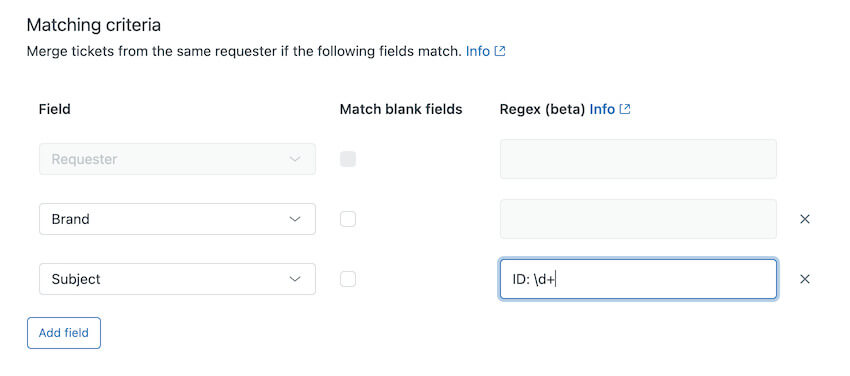
Source: Zendesk
5. Custom Views for Tickets:
Custom views allow agents to filter tickets based on predefined criteria, such as overdue tickets, tickets missing required fields, or those assigned to specific agents. These views streamline workflows and ensure agents prioritize tasks effectively.
Features Requiring Add-Ons or Workarounds
Some Zendesk features are partially supported but often require additional tools, higher-tier plans, or manual configuration to meet user expectations:
1. AI-Assisted Suggestions:
Zendesk’s AI-powered tools, such as Answer Bot, assist with routing tickets and suggesting tags or knowledge base articles. However, AI tools do not directly help agents enhance ticket details, such as identifying incomplete fields or recommending specific macros for complex issues.
2. Editable Custom Fields Post-Submission:
Custom fields can be edited after submission, but restrictions may apply depending on workflows or ticket statuses. For example, some fields may become locked once a ticket reaches a certain stage, requiring administrator intervention for updates.
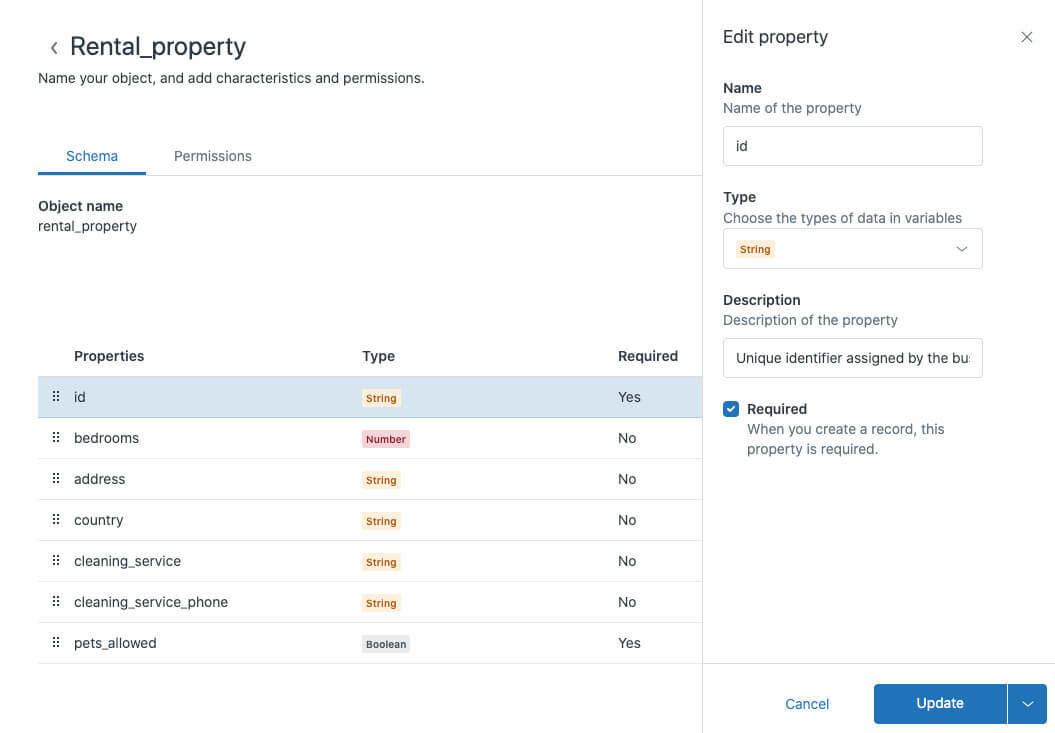
Source: Zendesk
3. Attachments Management:
Zendesk supports attachments in ticket comments, but it lacks advanced tools for managing them. Features like annotating attachments, previewing files directly within tickets, or organizing attachments into folders require third-party apps or custom-built solutions.
4. Advanced Reporting on Ticket Enhancements:
Zendesk Explore provides detailed reporting, including metrics on ticket resolution times, agent performance, and customer satisfaction. However, tracking specific changes made to ticket fields over time, such as who updated a field and when, typically requires leveraging APIs or third-party integrations.

Source: Zendesk
Features Missing Natively
Despite its robust feature set, Zendesk lacks some commonly requested ticket enhancement capabilities:
1. Ticket Splitting:
While ticket merging is natively supported, splitting a ticket into multiple tickets when customers report multiple issues is not. Agents must duplicate tickets manually or use third-party apps, which can be time-consuming and error-prone.
2. Searchable Side Conversations:
Side Conversations are a powerful collaboration tool, but they are not indexed in Zendesk’s search functionality. Agents often need to sift through tickets manually to locate specific conversations, impacting efficiency.
3. Customizable Prompts for Agents:
Zendesk does not provide built-in prompts to remind agents about missing fields, required updates, or follow-ups. Custom workflows and automations can partially address this gap but require administrative effort to implement and maintain.
Competitor Comparison: Native Features Zendesk Lacks
When evaluating customer support platforms, it’s essential to consider how competitors address gaps in Zendesk’s offerings. Below is an expanded look at the key native features provided by other vendors that Zendesk either lacks entirely or offers through add-ons:
Freshdesk
- Ticket Splitting: Freshdesk allows agents to separate multiple customer issues reported within a single ticket into distinct tickets, each with its own resolution path. This native feature eliminates the need for manual duplication and reduces confusion in handling complex tickets.
- Attachment Annotation: Agents can annotate attachments directly in Freshdesk, adding comments or highlighting specific areas to provide better clarity during ticket resolution.
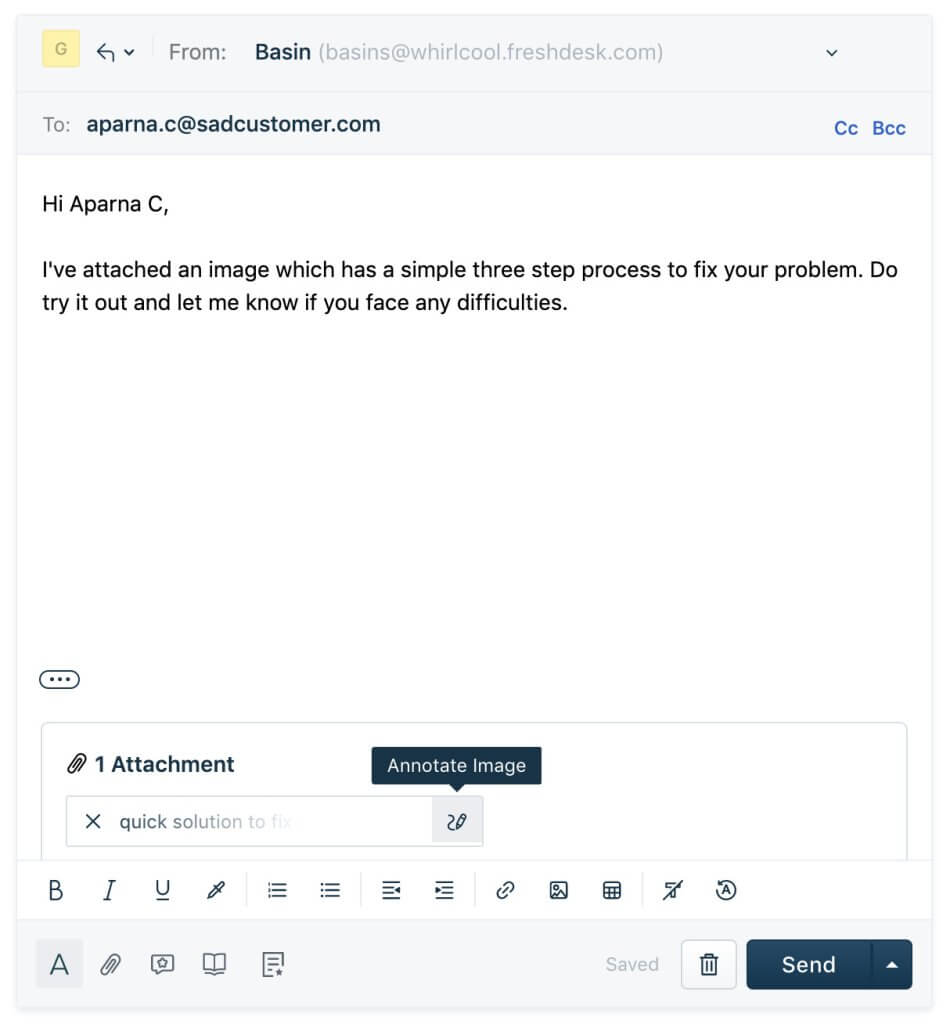
Source: Freshdesk
Intercom
- Searchable Internal Notes: Intercom ensures all internal notes and conversations are indexed and fully searchable. This feature enables agents to locate past discussions or crucial details quickly, enhancing efficiency in ticket resolution.
- AI-Powered Ticket Enhancement Suggestions: With Intercom, agents receive intelligent, AI-driven suggestions for improving ticket details. These include recommended tags, missing field prompts, or suggested content from knowledge bases tailored to the ticket context.
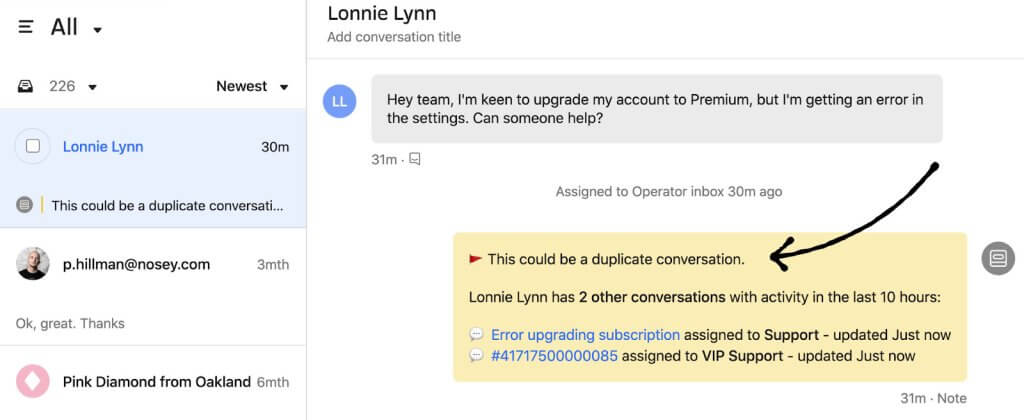
Source: Intercom
ServiceNow
- Customizable Agent Prompts: ServiceNow provides advanced tools for admins to create agent-facing prompts. These prompts ensure tickets meet quality standards by reminding agents to update missing fields, follow workflows, or adhere to SLAs.
- Detailed Change Tracking: Native tracking logs provide a comprehensive history of every field change, including timestamps and user information. This level of visibility is vital for audits, compliance, and resolving discrepancies in ticket handling.

Source: ServiceNow
Zoho Desk
- Searchable Side Conversations: Zoho Desk indexes side conversations, making them searchable alongside tickets. This feature significantly reduces the time spent retrieving critical information from prior communications.
- Automated Ticket Enrichment: By pulling customer data from integrated CRMs or databases, Zoho Desk automatically enriches tickets with relevant information, such as contact details, past purchases, or interaction history. This reduces manual data entry and enhances context.
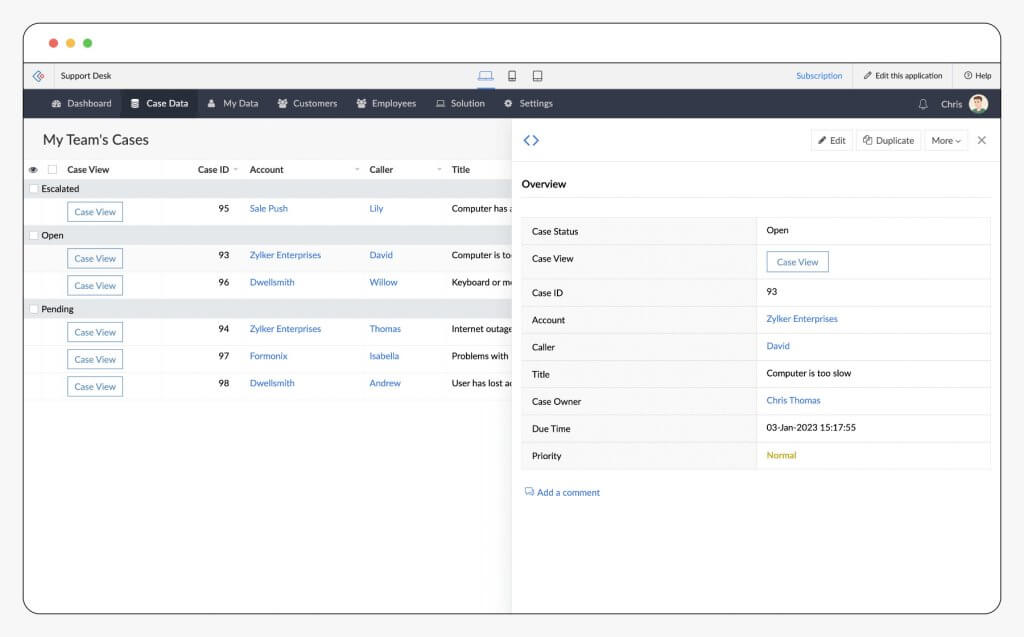
Source: Zoho Desk
Help Scout
- Contextual Customer Insights: Help Scout’s ticket interface includes a sidebar that displays relevant customer information, such as their recent interactions, support history, and account details. This real-time context helps agents provide tailored and proactive support.
- Streamlined Workflows: Help Scout offers out-of-the-box workflows designed to simplify ticket assignments, prioritization, and escalations. These workflows require minimal setup and adapt to various team sizes without additional tools.
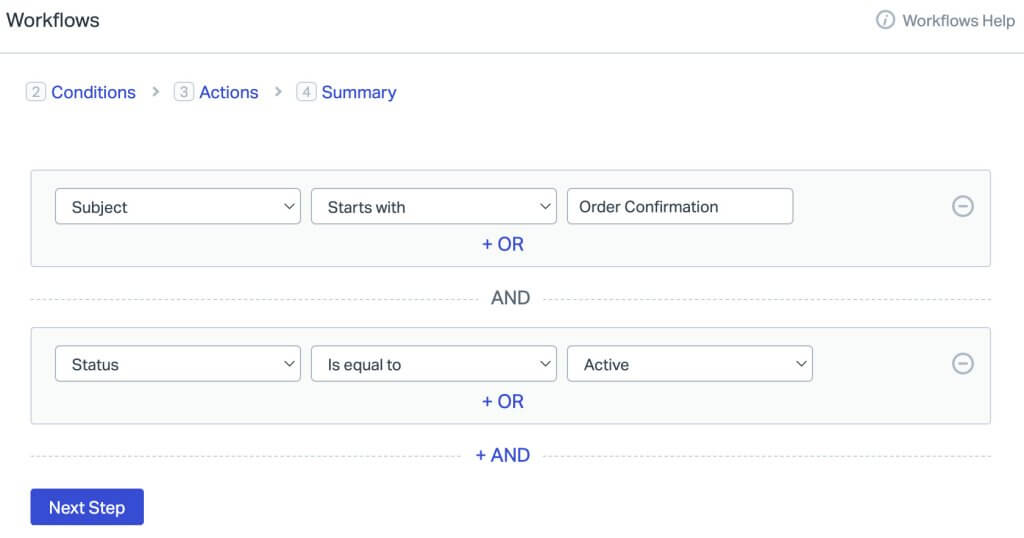
Source: Help Scout
Kustomer
- Ticket Timeline Views: Kustomer presents a visual timeline of ticket updates, showing when changes occurred, who made them, and the exact modifications. This feature is ideal for auditing and understanding the progression of complex issues.
- Advanced Conversation Management: Kustomer offers seamless tools for splitting and merging conversations. This functionality allows agents to handle multi-issue tickets effectively, ensuring each concern is tracked and resolved separately.
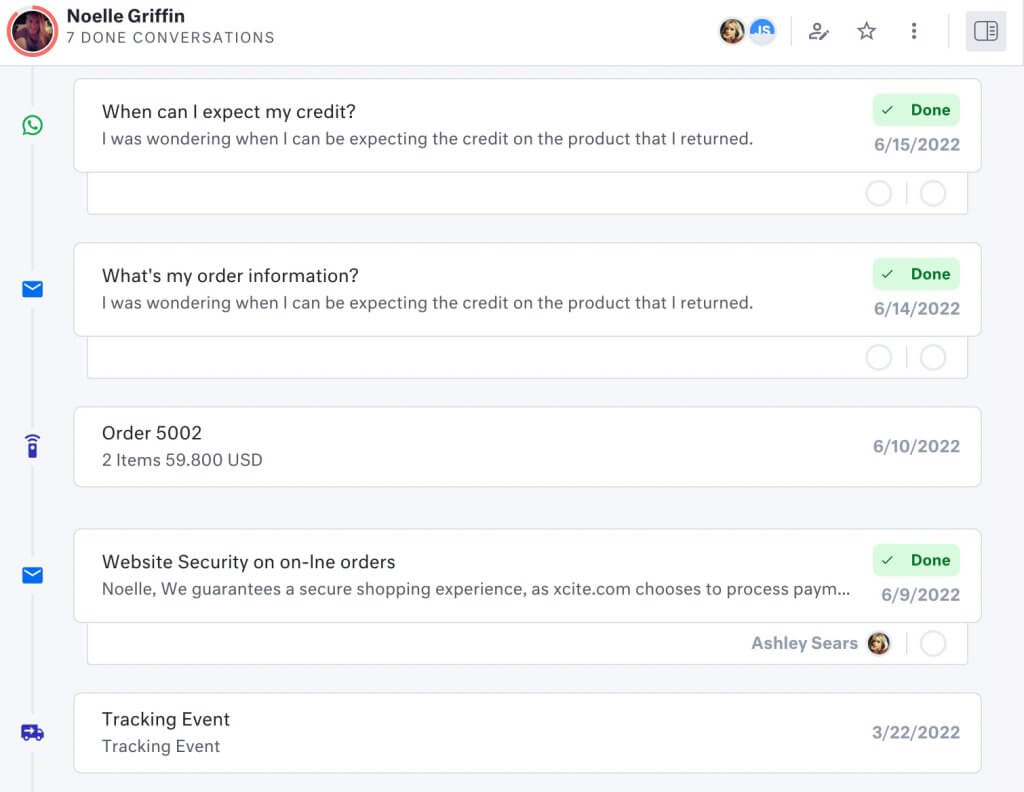
Source: Kustomer
These native features offered by competitors address common customer support challenges and streamline operations. By providing advanced capabilities like searchable side conversations, ticket splitting, automated enrichment, and dynamic workflows without requiring add-ons, these platforms offer a competitive edge. Businesses seeking enhanced agent productivity and better ticket management may find these features invaluable when considering alternatives to Zendesk.
Conclusion: Does Zendesk Meet Your Needs?
Zendesk provides a strong foundation for ticket management and enhancement, with features like rich text formatting, batch editing, and ticket merging. However, for businesses with advanced requirements, some capabilities require higher-tier plans, third-party tools, or custom development. Key gaps, such as ticket splitting and searchable side conversations, remain unmet by Zendesk natively.
For organizations that prioritize these missing features, exploring alternative vendors like Freshdesk, Intercom, or ServiceNow may be worthwhile. Each platform has its strengths, and choosing the right one depends on your team’s unique workflows and needs.
Whether Zendesk meets your needs depends on the complexity of your workflows and your willingness to invest in add-ons or custom solutions. For businesses seeking advanced features, exploring the Zendesk Marketplace or leveraging APIs may be necessary.



